|
 Rhizopogon rubescens Rhizopogon rubescens
SynonymsHysterangium rubescens
BiostatusPresent in region - Exotic
Images (click to enlarge)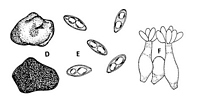
Caption: Figs.2 R. rubescens: D Habit and section (Beaton 71) x 1; E spores x 1750; F basidia x 1000. | 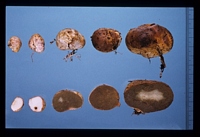
Caption: REB-1A, 23/4/79, Pinus, Waitakares
Owner: Ross Beever | 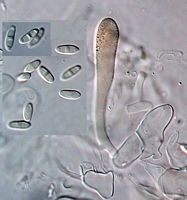
Owner: J.A. Cooper | 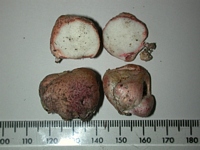
Caption: fruitbody
Owner: J.A. Cooper | 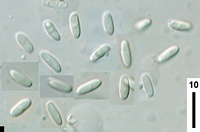
Owner: J.A. Cooper | 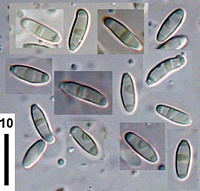
Owner: J.A. Cooper | 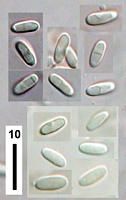
Owner: J.A. Cooper | 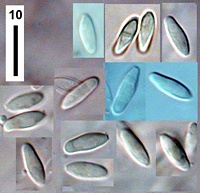
Owner: J.A. Cooper | 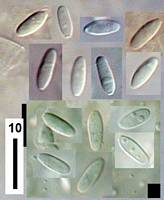
Owner: J.A. Cooper | 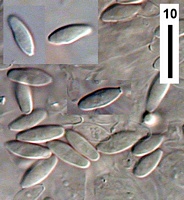
Owner: J.A. Cooper | 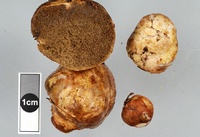
Owner: J.A. Cooper |
Article: Beaton, G.W.; Pegler, D.N.; Young, T.W.K. (1985). Gasteroid Basidiomycota of Victoria State, Australia: 5–7. Kew Bulletin 40(3): 573–598.
Description: Gasterocarp 1 5-3(-6) cm diam., subglobose to irregularly ellipsoid, attached on the lower half by scanty, yellowish rhizomorphs which blacken on
drying. Peridium at first cream colour to light yellowish brown, drying reddish brown to almost black, with some reddish purple patches, smooth to
finely wrinkled or irregularly tessellate. Gleba at first cream colour then Pompeian yellow (M.8.5YR/6.2/6.2), darkening from the centre to olive-brown at maturity, labyrinthoid, composed of partially filled, irregular chambers, 0 2-1 mm diam. Tramal plates 100-175 µm thick, subgelatinous to
gelatinous, consisting of a narrow hymenophoral trama and moderately developed subhymenial layers; peridial context neither gelatinized nor
agglutinated, with thin-walled, uninflated or slightly inflated hyphae, 2 5-14 µm diam., together with scattered oleaginous hyphae, 8-12 µm diam.,
with hyaline, refractive contents; clamp-connexions absent. Spores 7.5-10.5 x 2.5- 4(9± 0.5 x 3.5± 0.2) µm, Q= 2.57, symmetric or nearly so,
cylindrico-ellipsoid, with a small basal scar but scarcely truncate, at first hyaline becoming pale brown, with a slightly thickened smooth wall. Basidia
22-28 x 7-8 µm, lageniform with a ventricose base and a tapering apex, developing a variable number of sterigmata, but mostly four or six; numerous
immature, ovoid basidia also present. Basidioles few to abundant, sometimes dominant, 10-30 x 6-10 µm, ovoid, ellipsoid or clavate, internally
developing a very thick mucilaginous wall leaving a narrow lumen. Hymenophoral trama subregular, hyaline, subgelatinized, of loosely woven
refractive hyphae, 2-8 µm diam., with a thin or thickened wall. Subhymenial layer 10-22 µm wide, pseudoparenchymatous, conspicuous. Peridiopellis
a repent epicutis, about 40 µm thick, of narrow hyphae, 3-6 µm diam., with a pale brown wall, heavily encrusted with reddish brown granules; also
present numerous, amorphous, brown pigmented bodies.
Notes: Rhizopogon rubescens, in addition to R. luteolus, has also been introduced into Australia with Pinus. According to Cunningham (1944: 45) it occurs
abundantly with Pinus radiata with which it forms a mycorrhizal association in both Australia and New Zealand. The rhizomorphs tend to be less
conspicuous than in R. luteolus and the gleba is not so gelatinized so that it may be easily sectioned when dry.
Considerable confusion still exists in the literature over the correct name for this species. Svrcek (1958: 130) included R. rubescens under the name R.
roseolus (Corda) T. M. Fries, whilst Lange (1916: 53) maintained that there were two species in Europe, R. rubescens with spores 6.7-9.5 x 2.6-3.2
µm, and R. roseolus with spores 8-10.5 x 3.5 4.5µm. Smith & Zeller (1966: 88) recognized differences in gasterocarp pigmentation between the two
species.
Article: Gadgil, P.D. (in association with Dick, M.A.; Hood, I.A.; Pennycook, S.R.) (2005). Fungi on trees and shrubs in New Zealand. Fungi of New Zealand. Ngā Harore o Aotearoa 4: xi + 437 p. Hong Kong: Fungal Diversity Press.
Description: Type: Mycorrhizal Fungi; Description: Basidiomata hypogeous to subepigeous, irregularly globose, white at first then lemon yellow, tinged red when bruised, up to 60 mm in diameter, with weakly developed rhizomorphs; peridium composed of a single layer, yellowish brown in section. Gleba firm, reddish brown to greyish brown; tramal plates enclosing subglobose empty locules. Basidiospores elliptical, 0-septate, 6–9 × 3–4 μm, smooth, pale yellow.
Distribution: Distribution: Northland, Auckland, Coromandel, Waikato, Bay of Plenty, Taupo, Wanganui, Gisborne, Hawkes Bay, Nelson, Buller, Westland, North Canterbury, Mid Canterbury, Dunedin, Southland.; 1st Record: Chu-Chou (1979).
|